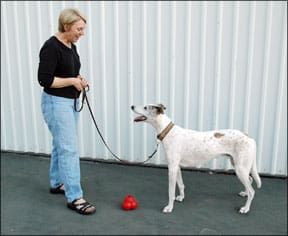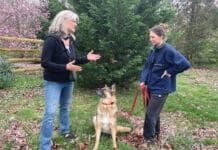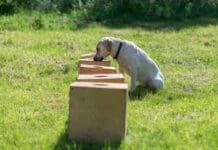[Updated August 9, 2017]
There’s nothing like a steaming-fresh pile of moist, warm horse manure to convince a dog owner of the vast difference between canine and human sensibilities – or of the great value of a reliable “Leave it!” cue. Since my husband and I share our lives with four dogs and 15-some equines, you can imagine that “Leave it!” is an important entry in our dogs’ lexicon.
You don’t have to live on a horse farm to appreciate the value of “Leave it.” A kitty-litter box can be just as tempting as a stall full of horse “apples.” The “Leave it” behavior, defined as “look away from whatever you’re looking at or coveting at this moment,” is useful in an almost infinite number of possible canine encounters:
• You drop your high-blood pressure pill on the floor. “Leave it! Good dog!”
• Your two-year-old child toddles past with a melting ice cream cone in his hand at canine nose level. “Leave it! Good dog!”
• You see your Irish Wolfhound studying the holiday turkey on the kitchen counter at canine eye-level. “Leave it! Good dog!”
• Your adolescent Labrador Retriever is preparing to offer an enthusiastic greeting to your elderly Aunt Maude who is approaching up the front walkway with the assistance of her wheeled walker. “Leave it! Good dog!”

• Your cat-chasing Jack Russell Terrier spots a black-and-white “kitty” (think skunk) trundling across your backyard at dawn when you let him out to potty as you’re rushing to get to a critically important meeting on time. “Leave it! Very good dog!” You just saved your job!
• You’re walking your dog in the park and spot a half-dozen suspicious-looking balls of raw hamburger at the same instant your dog does. “Leave it! Very very good dog!” You just saved your dog’s life; the hamburger was laced with strychnine.
I could go on, but I’m sure you get the picture. A cue that can divert your dog’s intention to chase, greet, or eat someone or something is a life-saving, sanity-saving, versatile, mandatory part of every well-mannered canine companion’s behavior repertoire. So how do you go about helping your dog acquire this vital skill? It’s easier than you might think.
Training a Dog to Leave It: Step 1
The foundation “Leave it” behavior is so important – and so simple – that we teach it in our Puppy and Adult Basic Good Manners classes. We introduce it in Week 4, and it’s an exceedingly rare dog who doesn’t perform it to near-perfect on graduation night just three weeks later. Here’s how it works:
Show your dog a high-value “forbidden object” – something you’re going to tell him he can’t have. I like to use freeze-dried liver cubes for this – they are high value and durable. (You’ll see why durability is important in just a minute). Let him sniff it, lick it, even nibble at it, but don’t let him have it.
Now say “Leave it!” as you hold up the cube, then immediately place it on the floor under your foot, to protect it. Note: Be sure to wear sturdy shoes. Do not do this exercise barefooted, with open sandals, or in your Sunday-best patent leathers.
Let your dog sniff, lick, and nibble at the treat under your foot. He might even chew at it. If his tongue can reach the cube under your shoe, tip your toe forward so he can’t actually lick it. You don’t want him getting reinforced even by a tiny taste, if you can help it.

Now just wait. Don’t repeat the cue; he will eventually give up. I promise. The split second he stops sniffing, licking, etc. or looks away, even if it is by accident, “mark” the moment by clicking your clicker or saying “Yes!” and give him a tasty treat. He’ll probably return his attention to the forbidden object under your foot after the click and treat, so just wait some more. Don’t repeat the cue. (See why below.) When he looks away again, click and treat again.
If you can, give him another click and treat before his nose returns to your foot. You want to reinforce the behavior of “look away, look away, look away, keep looking away” as much as possible; you’re not looking to create a behavior chain of “look at foot, look away, look at foot, look away (although you will get some of this, at least at first). After several repetitions, pick the cube up from under your foot, show it to him again, now repeat the “Leave it” cue, and place it under your foot again.
When he looks away from the inaccessible cube easily, you’re ready for the next step. Move your foot away slightly to uncover the treat and give repeated clicks and treats as long as his nose doesn’t return to the treat. This communicates to him that he gets rewarded for staying away from the cube, even when it’s visible and seemingly accessible. Keep your foot close! You may want to just keep your heel in place and pivot your toe away from the treat at first. If your dog dives for the food, just re-cover it with your toe to prevent him from getting it. Click (and treat) again when he looks away.
If your dog appears to have completely forgotten that the forbidden object is on the ground, every once in a while you can tap your toe next to it to draw his attention back, but be ready to cover it up quickly! Remember, he doesn’t have to look back at the cube and then look away – you want continuous “look away” behavior.
Eventually you will see your dog’s “Aha!” moment – that golden moment in training when you get to see your dog really understand what you’re asking him to do. With “Leave it” that golden moment happens when he looks at the exposed cube, considers it for a moment, and then looks up at you in anticipation of his click and treat. Celebrate!
Don’t Repeat the Cue!
It is almost irresistibly compelling to repeat the cue when your dog makes a move for that liver cube. It’s hard to resist the normal human automatic reaction to tell the dog what to do even when you know your dog doesn’t yet understand what the words mean. We are a verbal species; our dogs are not.
When you cover the cube with your foot rather than repeating the cue, you’re speaking your dog’s language – using body language to communicate to your dog that the cube belongs to you, and he can’t have it. In fact, the reason this exercise works so well is that when you cover the forbidden object with your foot, you’re resource-guarding. Now that’s a behavior your dog understands – dogs do it all the time!
You also want your dog to understand that once you’ve said “Leave it” you mean “leave it forever.” You don’t want to have to keep reminding him.
Imagine you’re having a cocktail party. You carry your tray of hors d’oeurves into the living room, and as you bend down to place them on the coffee table, you tell your dog to “Leave it!” You don’t want to spend the rest of the evening guarding the goodies; you want your dog to leave them alone for the duration of the party.
ln order to accomplish that desirable end, don’t repeat the cue. Use your foot to protect that liver cube, or body block to send the resource-guarding message. Show your dog with your body language that the cube belongs to you; resist the temptation to tell him. Then when you’re done practicing, pick the cube up and put it away for the next training session, or feed it to him in a different location. Don’t make the mistake of telling him he can have it. Remember, “Leave it” – one cue – means “Ieave it forever.”
Training a Dog to Leave It: Step 2
When you can routinely place the forbidden object on the floor without your dog trying to get it, without having to cover it with your foot, you’re ready for step two – the “Leave it/Drop.” This step starts to approximate some real-life applications of “Leave it.” For example, the situation described in example #1 above, where you drop your medication – or perhaps a piece of chocolate candy (chocolate can be deadly to dogs).

Warm up your dog’s “Leave it” as described above. When he’s easily leaving the cube, stand facing him with the cube in your hand, say “Leave it!” and drop it slightly behind you and slightly off to one side.
Whoops, be careful! A poorly placed drop and the cube can take a bad bounce, landing directly under your dog’s eager jaws. Err on the side of caution, especially at first. Behind, and slightly off to one side. If your dog moves to grab the cube, body block by stepping in front of the dropped object or by covering it with your foot. Don’t yell “Leave it!” or make any other aversive noise. Just protect the object so your dog can’t get it, wait for him to look away from it, and then click and treat.
Now pick the cube up and try again, using your calm “Leave it!” cue with each drop repetition, until you can give the cue and drop the cube without having to make any protective maneuvers. Practice this until your dog will do “Leave it/Drop” without any prior warm-ups. Remember to click and treat each time your dog leaves the forbidden object alone, and to click and treat several times to extend the duration of his leave-it behavior. Now you’re ready for step three.
Training a Dog to Leave It: Step 3
How often do you have the chance to say “Leave it” before you accidentally drop your box of chocolates on the floor? Not too often, I’ll wager. To more closely approximate real life, you need to make one more adjustment to the “Leave it” exercise: the “Drop/Leave it.”
Warm up with several of your step two “Leave it/drop” repetitions. Now switch the order: drop the cube and say “Leave it” immediately after it hits the floor. Again, start with strategically placed drops so you can body block if necessary. In fairly short order you should be able to drop the cube in random locations, followed by a well-timed “Leave it” cue. Practice until your dog will leave it for you after the drop, even on “cold” trials.
Now you can generalize “Leave it” to more real-life situations.
The Generalized “Leave It”
It’s best to start generalization work with your dog on a leash. You’re going to be doing set-ups with forbidden objects that you won’t be able to cover with your foot, so you’ll need your leash to restrain your dog so he can’t help himself to the objects.
On a surface such as an asphalt or concrete driveway, or hardwood or tile floor, set up a “temptation alley” – a line of moderate- to high-value objects. Place the items in a line, five to 10 feet apart. Then approach the first item with your dog on his leash, far enough from the line that your dog can’t reach the objects.

When your dog notices the first item in the line, say “Leave it!” in a cheerful tone of voice, and stop moving. Restrain your dog so he can’t grab the object. You should be far enough from the line that you don’t have to jerk him back to keep him from getting it. Like you did with the liver cube under your foot, just wait for him to give up and look away from the object. The instant he looks away, click and treat, then move forward. If he pulls toward the object when you move forward, stop, give another “Leave it!” cue, and wait until you can click him again for looking away. If he doesn’t look at the object as you move forward, continue to click and treat him for good leash walking, until he notices the next object.
Repeat the exercise with that object. Continue on until you can pass the whole line of tempting items, and he will respond to your “Leave it” cue without ever putting any tension on the leash.
Your goal is to get your dog to reliably respond to the “Leave it!” cue on cold trials (first time you present a new forbidden object) without putting any tension on the leash. When he’ll do that, he’s ready to try it off leash!
Now look for random real-life opportunities to try out his new skill, on-leash or off. Remember to keep your cue cheerful; you’re just giving your dog information (“Look away from that object for an opportunity to be reinforced”). You’re not trying to intimidate him away from the object. If you see any lapses in his real-life random trial “Leave it” responses, schedule more on-leash set-up training sessions. If his training carries over successfully to real life, the two of you have earned another celebration!
With 15 horses on our farm, each producing approximately 35 pounds of poop per day; random groundhogs, deer, toads, and baby birds outdoors; three chaseable indoor-only cats, and a variety of dropped items and other “forbidden object” occasions around the house, “Leave it” is a common household cue for our dogs.
One of my most rewarding stories comes from a client of mine in Tennessee, however, who tells of his dog finding poison meatballs in his own backyard, immediately returning to his owner’s side when cued to “Leave it.” His dog’s prompt response even when tempted by the tasty but deadly morsels likely saved his life.
Pat Miller, CBCC-KA, CPDT-KA, is Whole Dog Journal’s Training Editor. Miller lives in Hagerstown, Maryland, site of her Peaceable Paws training center. Pat is also author of The Power of Positive Dog Training; Positive Perspectives: Love Your Dog, Train Your Dog; Positive Perspectives II: Know Your Dog, Train Your Dog, and the brand-new Play with Your Dog.






